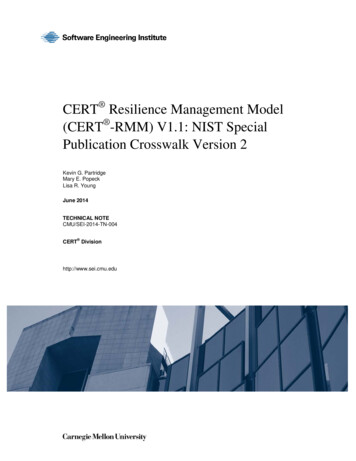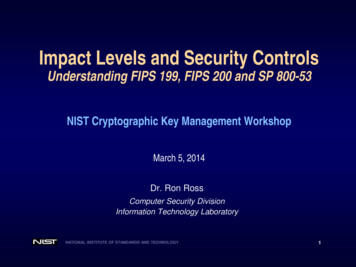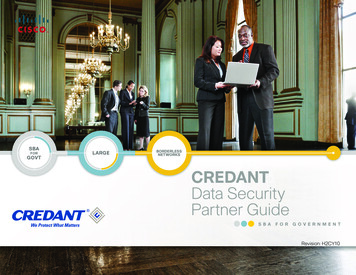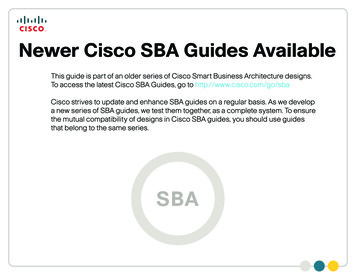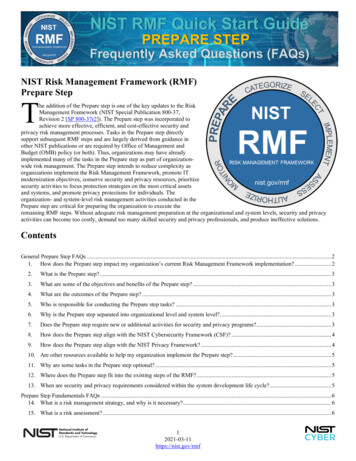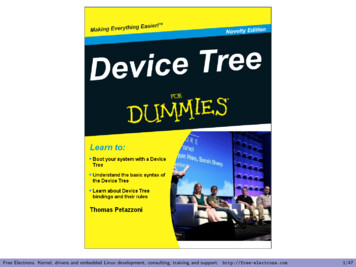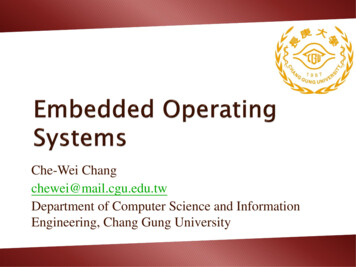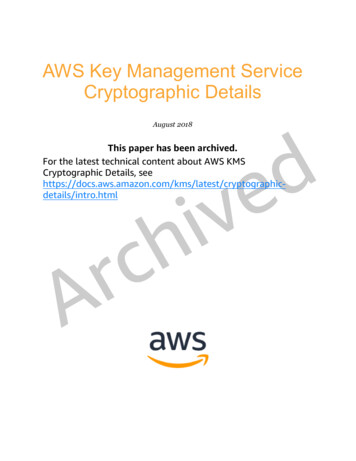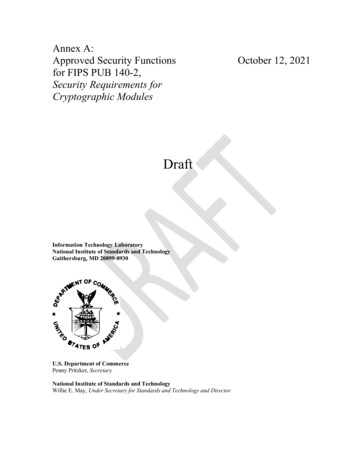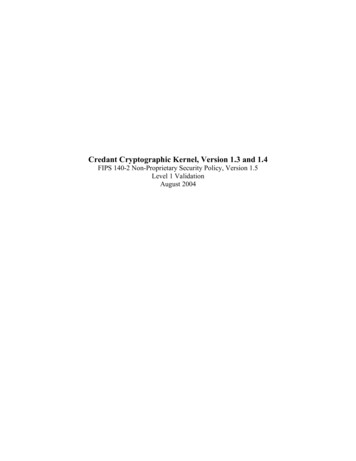
Transcription
Credant Cryptographic Kernel, Version 1.3 and 1.4FIPS 140-2 Non-Proprietary Security Policy, Version 1.5Level 1 ValidationAugust 2004
1.INTRODUCTION32.PRODUCT, BOUNDARY, MODULE DEFINITION43.ROLES, SERVICES, POLICY64.FINITE STATE MODEL95.KEY MANAGEMENT106.MODULE INTERFACE127.SELF TESTS128.DESIGN ASSURANCE139.SECURE INSTALLATION AND OPERATION132
COPYRIGHT @ 2004, Credant Technologies Corporation. All Rights Reserved.“Credant”, “Credant Mobile Guardian” and all Credant logos are registered trademarks ofCredant Technologies Corporation. This document may be copied without the author’spermission provided that it is copied in its entirety without modification.1. IntroductionCompanies are increasingly using diverse mobile devices to store critical businessinformation, improve productivity and enhance customer relationships. These mobiledevices represent one of the most severe and often overlooked security threats to theenterprise. Frequently left unmanaged and with little to no enforced security, thesedevices are an open door to corporate applications, networks and databases and representpotentially significant financial, legal and regulatory liabilities. Without sufficientmanagement tools and enforced security policies, companies have no way to preventmobile security breaches, know if information is misused, or trace the source of mobilesecurity incidents.Architected to protect the mobile enterprise, Credant Mobile Guardian (CMG) is the firstsecurity solution that addresses an organization's mobile security issues with centrallymanaged policy administration and strong on-device user authentication and policyenforcement. This cost-effective solution enables organizations with a growing mobilepopulation to take full advantage of the benefits of today's mobile workplace and remainconfident that business critical information is secure.The Credant Cryptographic Kernel (CCK) is the library of cryptographic functions usedby the Credant Mobile Guardian (CMG) Suite of mobile security solutions. The CCKtakes the form of a (shared or dynamic link) software library, which provides an API tocryptographic functions, including AES, Triple DES, SHA-1, HMAC (SHA-1), and anANSI X9.31 compliant pseudorandom number generator.CMG Suite comprises the CMG Server, CMG Gatekeeper, and CMG Shield softwareproducts. These three components work together to ensure the security of data on mobiledevices. The CMG Shield installs on the mobile device and protects its data fromunauthorized access. The CMG Gatekeeper receives policy information from the Serverand communicates it to the devices running the Shield. An administrator sets companypolicies via CMG Server software, and the Server forwards these settings to the instancesof the CMG Gatekeeper. When a device synchronizes with its host PC, the Gatekeepercommunicates these policies to the device.3
2. Product, Boundary, Module DefinitionThe CCK library and header file constitute the cryptographic software module for thisFIPS 140-2 validation. The logical boundary contains the software modules thatcomprise the CCK library. The physical boundary for the module is defined as theenclosure of the computer system on which the functions of the library execute.Windows Physical and Logical Cryptographic BoundariesMicroprocessorVideo DisplayDriverMonitorData and ControlDisplay er faceMouseUser CommandsCCKDLLFiles andSoftwareSerialOS ParallelInterfaceNetworkInterfaceNetworkPC CardInterfaceOptionalHardwareData and parametersPowerSupplySystem BusPowerSourcePhysical Cryptographic Boundary4
PPC and Palm Physical and Logical Cryptographic BoundariesMicroprocessorVideo DisplayDriverData and ControlSystemMemoryScreenDisplay InformationKeyboardInterfaceDataKeyboardUser CommandsLogicalCryptographicBoundaryScreen InputInterfaceCCKDLLAdd-onMemoryUser CommandsSerialAdd-onMemoryInterfaceInterfaceFiles andSoftwareSerialOS tUniversalPort InterfaceTouchScreenNetworkInterfaceNetworkPC CardInterfaceOptionalHardwareData and parametersPowerSupplySystem BusPowerSourcePhysical Cryptographic Boundary5
The module constitutes a multi-chip stand-alone device (listed below), as defined by theFIPS 140-2 standard. The devices on which the CCK runs (as a shared or dynamic linklibrary) include: Intel-CPU-based computers running the Windows operating system:o Windows 2000, service pack SP1, ando Windows XP, service pack SP1Personal digital assistants running PalmOS (versions 3.5.1 and greater, butless than 5.0)PocketPC 2000, PocketPC 2002 and PocketPC 2003 handheld computersTelephony enabled PDAs including:o the HandSpring Treo,o the Kyocera,o the Samsung, ando Palm Tungsten WThe CCK was tested as a dynamic link library on a standard, commercially available IntelCPU PC (DELL OptiPlex GX1) running Windows 2000 and on a standard, commerciallyavailable X-Scale PPC (Compaq iPaq 3760) running Windows CE 3.0.3. Roles, Services, PolicyThe CCK supports both Crypto Officer (CO) and User roles, where a “user” is theapplication using CCK services to perform encryption, decryption, hashing, and randomnumber generation. It does not support a maintenance role or a bypass capability. TheCCK supports one Approved mode and it supports only FIPS 140-2 approved services(shown in Figure 1).In the CO role, the CO installs the CCK on a device. It is the CO’s responsibility toinstall the CCK in the Approved mode according to the instructions specified in Section 9of this Security Policy.6
The cryptographic services provided by the software module are shown in the Figure 1.Note that the supported services do not include authentication.Service TypeSymmetric CipherSymmetric CipherMessage AuthenticationMessage DigestRandom NumberGenerationAlgorithmAESTriple DESHMAC (SHA-1)SHA1ANSI X9.31FIPS19746-3198180-1186-2Available in e 1. Services offered by the Credant Cryptographic Kernel, applicable algorithmapplicable FIPS specification, and availability.7
The access granted to security relevant data items of these services for each role is shownin Figure 2. Note that the CCK FIPS 140-2 Vendor Evidence document enumerates theCCK API’s in this table along with the parameters passed to each in Appendix eExecute/ReadAESUserRead access to keyspassed as pointerparameters toconstant structures;no other access.ExecuteTriple DESUserExecuteHMAC(SHA-1)UserSHA1UserRead access to keyspassed as pointerparameters toconstant structures;no other access.Read access to keyspassed as pointerparameters toconstant structures;no other ationRun SelftestsShowstatusAccessibleSRDIType s)--None-CCK initializeCCK self tests,CCK conditional testCCK fips mode,CCK status,CCK test statusCCK set AES blocksize and key,CCK AES encrypt,CCK AES decrypt,CCK AES CBC encrypt,CCK AES CBC decryptCCK DES3 encrypt,CCK DES3 decrypt,CCK DES3 CBC encrypt,CCK DES3 CBC decryptCCK HMAC init,CCK HMAC destroy,CCK HMAC restart,CCK HMAC update,CCK HMAC truncated finalCCK SHA1 reset,CCK SHA1 get hash,CCK SHA1 update,CCK SHA1 truncateand report,CCK SHA1 final and report,CCK SHA1 finalCCK X931RNG generatebyteFigure 2. Access to Security Relevant Data Items (SRDI) for each service and role.8
Note that installation differs from initialization in that installation does not involveexecution of CCK services. Initialization must occur after installation is invoked by theCCK client, and results in execution of several CCK services in the process of creatingmemory and starting services necessary to support subsequent CCK operation.The inputs and outputs of each service are shown in Figure 3.The methods of the cryptographic software module are designed to be invoked by asingle process.ServiceInstallationInitializationRun Self testsShow statusAES encryption(ECB & CBC modes)AES decryption(ECB & CBC modes)Triple DES encryption(ECB & CBC modes)Triple DES decryption(ECB & CBC modes)HMAC (SHA-1)SHA1RNGInput/OutputInput: Installation CDOutput: Installed CCK softwareInput: Installed CCK softwareOutput: Initialized CCK software (and client application)Input: noneOutput: self test statusInput: noneOutput: module status indicatorInput: plaintext, key, IV in CBC modeOutput: ciphertextInput: ciphertext, key, IV in CBC modeOutput: plaintextInput: plaintext, key, IV in CBC modeOutput: ciphertextInput: ciphertext, key, IV in CBC modeOutput: plaintextInput: a file, keyOutput: authentication codeInput: a fileOutput: hash valueInput: date/time (D/T) & seed (V)Output: a random byteFigure 3. Inputs and outputs of each service provided by the CCK.4. Finite State ModelThe CCK uses a finite state model (FSM) to keep track of whether the module is in avalid state for performing cryptographic operations. The FSM resides in a thin layer ofcode between the API and the underlying cryptographic functions. The FSM guardsaccess to all cryptographic functions and requires that the software module be properlyinitialized and must pass self tests before allowing cryptographic functions to beperformed. It also tracks the state of conditional tests and continuous RNG tests. If any9
of these tests fail, the FSM goes into an error state, preventing any further cryptographicfunctioning.The FSM has the states shown in Figure 4.StateFSM CRYPTOOFFICERFSM POWER ONFSM RUNNING SELF TESTSFSM RUNNING CONDITIONAL TESTFSM USERFSM ERRORFSM POWER OFFDescriptionCrypto officer installs the CCKInitial (startup) state - self tests not yet runSelf tests are runningTest of specific method being invokedfrom FSM USER stateSelf tests have passed. Ready to acceptservice requestsSelf test or conditional tests failedCCK has been installed but is not runningFigure 4. States of the Finite State Model.5. Key ManagementThe CCK does not perform key generation or key establishment.The CCK does not perform key storage. Other than the key used to decrypt the libraryauthentication data, the CCK maintains keys only in memory and does not store keys topersistent media. Therefore it does not provide the means for key storage or retrievalbetween successive power up cycles of the device.The CCK does perform key input. All key values and initial values are generated bycode outside the cryptographic software boundary and are passed to the methods in theCCK by pointer reference. That is, they are stored in memory at an address allocated bycode outside the cryptographic software boundary. This is then passed to the methods ofthe CCK.The CCK does not perform key output. It has no key output methods nor any methodsthat have the effect of key output.All secret keys and CSPs (including RNG seeds) used by the CCK are protected by theabsence of any methods provided by the CCK API that enable, allow, or contribute to thedisclosure, modification, or substitution (authorized or unauthorized) of any key, initialvalue, or seed passed into or used by the CCK.All CSPs used internally by the CCK (i.e. not passed to the CCK), such as those used bythe random number generator, are protected by being zeroized immediately after use.10
However, since the CCK does not own the memory in which the keys and initial valuespassed to it are stored, zeroization of these keys and initial values is the responsibility ofthe client code that calls the CCK. The Crypto Officer could also zeroize these keys andinitial values by reformatting the hard drive.Occasionally, the memory containing keys and CSPs can be swapped by the Windowsoperating system to the hard drive of the PC, or by the PocketPC operating system toother persistent memory. In order to zeroize these keys and CSPs, these swap files (ormemory) must be wiped by the User. Wiping the swap files can be performed byreformatting the hard drive of the Windows PC on which the swap file resides, or byinitiating a hard reset of the PocketPC device. PalmOS has no such issues since it doesnot perform virtual memory management.The HMAC key and signature used to validate the CCK library are protected by beingAES-128 encrypted. After validation is performed, the decryption key, decrypted HMACkey, and decrypted HMAC signature are all protected by being zeroized immediatelyafter use.11
6. Module InterfaceFigure 5 maps elements of the API to the four required components of the logicalinterface.Logical InterfaceComponentData InputData OutputControl InputStatus OutputPowerCorresponding APIcomponentAPI functions that accept inputdata argumentsAPI functions that produce outputin arguments and return valuesAPI functions to initialize andshutdown the module and to runself testsAPI functions which returninformation regarding modulestatusN/APhysical PortsStandard Input Ports (e.g.,Keyboard)Standard Output Ports (e.g.,Serial Port)N/AStandard Output Ports (e.g.,Monitor)Supplied by deviceFigure 5. Logical interface components, API components, physical ports.7. Self TestsWhen the CCK library is loaded, self-authentication is performed to ensure that thelibrary has not been modified. The self-authentication is performed using HMAC (SHA1) to compute the message authentication code of the library and is compared to anexpected value. If the computed and expected values do not match, the attempt to loadthe library will fail. Otherwise, it will succeed. Subsequent to successful selfauthentication, the CCK implements a number of self-tests to ensure that it is functioningproperly. On startup, the CCK executes known answer tests (KATs) on all itscryptographic functions (listed in Figure 1) before any cryptographic functions can beexecuted. In addition, the required continuous RNG test ensures that the RNG generatesdistinct arrays of bytes on each call.If any of these tests fail, the FSM controlling the operation of the CCK enters an errorstate, preventing any further functioning of the CCK. To recover from an error state, thepower to the CCK must be recycled. If the CCK remains in the error state after a powerrecycle, the hard drive of the PC must be reformatted to ensure that all keys and CSP’sused by the CCK are zeroized or a hard reset performed on the PocketPC or Palm device.Thereafter, the CCK must be reinstalled. There are no other means for recovering froman error state.12
The self-tests can be run on demand by power cycling the device running the CCK. TheCCK library also contains an API, enabling the user to execute the self-tests.8. Design AssuranceA configuration management system is used to control the versions of the source codecomponents of the cryptographic software module. Each source file component ischecked into the Concurrent Versions System (CVS). CVS is a well-known versioncontrol system that allows multiple software developers to change the same source fileswhile maintaining records of each version and requiring resolution of conflictingchanges. As part of this, CVS assigns each version of a file a unique version number.Each version of every file that is part of a commercial release of the software is taggedwith a unique identifying name, and the CCK library is then built from those taggedsource files.Version information governing this Security Policy and operator documents ismaintained/tracked in a version control document, which is stored in CVS. The versionsof the operator documents are controlled in an archive system.9. Secure Installation and OperationSecure installation of the CCK must be performed by an employee playing the role ofCrypto Officer at Credant Technologies or by a Crypto Officer at the company using theCCK or its associated products. Installation must be performed according to theinstructions in the Installation Guide accompanying the CCK or its associated products.There is no special action the Crypto Officer must perform to ensure that the CCK isoperated in FIPS mode. The CCK operates in FIPS mode by default.Secure operation of the CCK requires that each instance of the library be used by onlyone user and only one user at a time. In addition, the application that constitutes the Userof the CCK must call the “CCK initialize” method to initialize the CCK. Beforeinitialization, no cryptographic functions are available. When “CCK initialize” is called,the self-tests are automatically invoked, and if and only if the tests pass, the module isavailable to perform cryptographic functions.The operating system should also enforce single-operator mode of operation. MicrosoftWindows 2000 operating system supports multiple concurrent (networked) users but onlywhen Terminal Services is activated. These services should not be activated in order torestrict the system to single operator mode.Please consult your IT administrator and the requisite Microsoft documentation forinformation on how to ensure that Terminal Services are not activated.13
The Credant Cryptographic Kernel (CCK) is the library of cryptographic functions used by the Credant Mobile Guardian (CMG) Suite of mobile security solutions. The CCK takes the form of a (shared or dynamic link) software library, which provides an API to cryptographic functions, including AES, Triple DES, SHA-1, HMAC (SHA-1), and an

